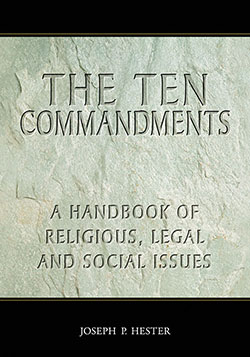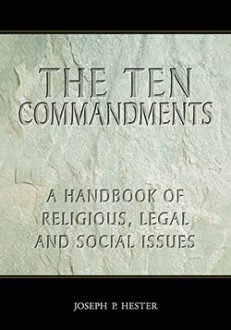The Ten Commandments
A Handbook of Religious, Legal and Social Issues
$49.95
In stock
About the Book
The founders of the United States were well aware of religious differences in the new nation. Oppression had forced varied European religious groups to seek homes elsewhere, some in the new world of America. Governmental pressures toward conformity in religion had in the past led to corruption and civil strife. Thus, Congress made a dual assertion in its First Amendment to the Constitution: “Congress shall make no law respecting an establishment of religion, or prohibiting the free exercise thereof.” However, the ethical foundations of American society—and therefore its laws—intermingle with the moral codes of religions, including the Judeo-Christian Ten Commandments.
This handbook helps bring understanding and meaning to the controversies that have arisen in present day society over the application of the Ten Commandments to public law and moral problems. Applications can be logical and legal, or can violate the separation of church and state called for in the First Amendment. Part One provides background on the Ten Commandments. It gives the various versions found in the Old Testament, and explains the non–Israelite influences on those versions (the Hammurabi Code, for example). The moral thinking of the ancient Mesopotamian, Egyptian and Hebrew cultures is examined. The modern Jewish tradition is detailed, as well as the different interpretations placed on the Ten Commandments by Roman Catholics, Anglicans, Lutherans and other Protestants. Part Two focuses on the modern controversies, assessing the differing sides of each. Among the many controversies covered are government funding of faith-based charities, posting the Ten Commandments in public buildings, science versus religion in schools, prayer in public places, blue laws, stem cell research, cloning, euthanasia, capital punishment, abortion and war, racial profiling and covenant marriages.
About the Author(s)
Bibliographic Details
Joseph P. Hester
Format: softcover (7 x 10)
Pages: 291
Bibliographic Info: glossary, notes, bibliography, index
Copyright Date: 2006 [2003]
pISBN: 978-0-7864-2658-4
eISBN: 978-1-4766-0861-7
Imprint: McFarland
Table of Contents
Preface 1
Introduction 3
PART I: THE HISTORY AND MEANING
1. Biblical Content 13
Versions of the Ten Commandments 14
Analysis of the Ten Commandments 17
Interpretation of the Ten Commandments 19
2. Ethical Inquiry and the Development of Morality
Approaches to Ethical Inquiry 27
The Development of Moral Thinking in Ancient Cultures 33
Three Types of Religious Ethics 43
3. Reflective Morality 54
The Role of Reason in Ethics 56
Religion as a Type of Ethic 69
PART II: ISSUES AND CONTROVERSIES
4. Separation of Church and State 77
Controversy: Funding the Faithful—Faith-Based Initiatives 80
Controversy: Posting the Ten Commandments in Public Buildings 112
Controversy: Character Education—What Values Do We Teach? 125
5. “Thou Shalt Have No Other Gods Before Me” 131
Controversy: One Nation Under God? 134
Controversy: Religion, Science, and the Schools—Evolution or Creationism? 145
Controversy: Prayer in Public Schools 154
Controversy: Keeping the Sabbath Holy 164
6. “Thou Shalt Not Kill” 173
Controversy: Federal Funding of Stem Cell Research—Extending the Cloning Controversy 174
Controversy: Is Euthanasia Ever Morally Correct? 212
Controversy: Capital Punishment 218
Controversy: The Morality (or Immorality) of War 223
Controversy: Is Abortion Murder? 227
7. “Thou Shalt Not Bear False Witness”
Controversy: Racial or Religious Profiling 236
8. “Thou Shalt Not Commit Adultery” 240
Controversy: Covenant Marriage 241
Glossary 247
Notes 253
Bibliography 269
Index 281
Book Reviews & Awards
“thorough notes are included…useful…recommended”—Choice; “commentary is balanced and well-researched”—C&RL News; “interesting information”—The Society for Old Testament Study; “useful”—ARBA; “discussion throughtout is comprehensive, lucid and serves in many ways as an introduction to general ethical theory. This is enhanced by extensive references to North American legal cases, bibliographies, references and a glossary”—Theological Book Review.





